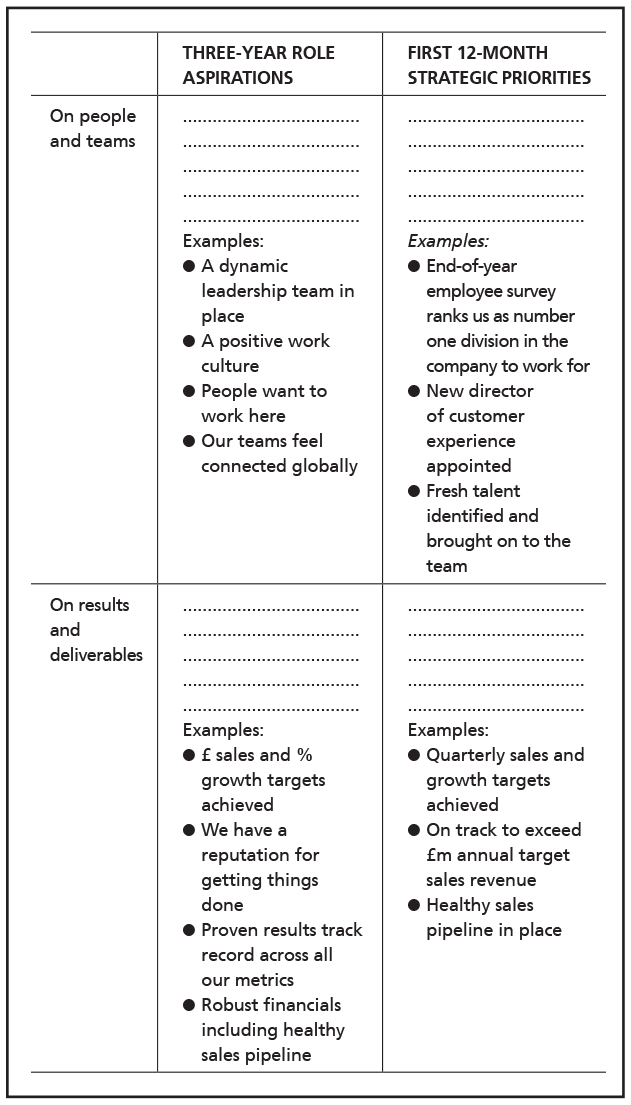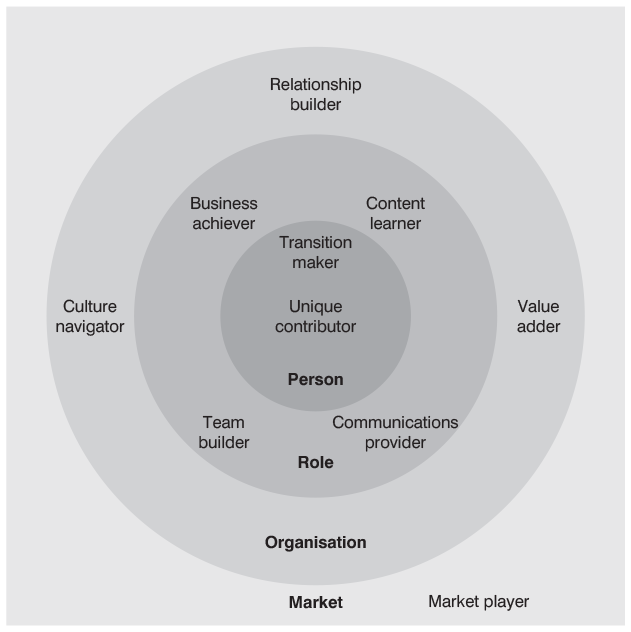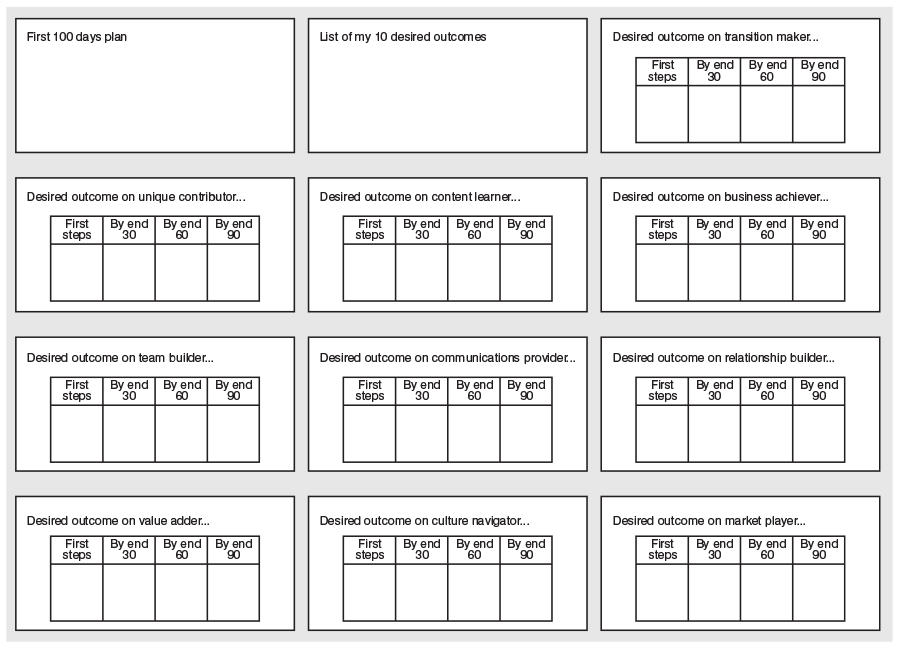Write your First 100 Days Plan
- Consider your leadership purpose – think big and take risks
- Be strategic and start your plan with the end in mind
- Apply the First100assist™ framework
- Executive Q&A: advice on writing the best first 100 days plan
1 Consider your leadership purpose – think big and take risks
Before you zone in on writing your first 100 days plan, it is a good idea to pause and think about this role in the context of the bigger picture for your career. Ask yourself why you are really taking on this new role challenge and how the role will help you with your career goals. For example, this role may be a stepping stone to a bigger promotion, and you may want to become a top leader of the firm or even the CEO. Think about your longer-term career goals and strategy, and how this role can set you up for that.
Go even bigger and think about what really matters to you in life and could give purpose to your leadership life – and see how you could reframe this new role with that in mind. For example, your true leadership mission and purpose may be to inspire people to make a difference, change the world, save the environment or improve the work and lives of others. If you find a way to align the success of this role with both your leadership purpose and career path, you will tap into a virtually unlimited inner well of energy, passion and resourcefulness when it comes to writing your first 100 days plan.
- Why did I take the job?
- What would make it more meaningful?
- Is this about a path for future promotion?
- How does this new role fit in with my longer-term career goals?
- How does this role fit in with fulfilling my leadership purpose and my career ambitions?
A new role is an opportunity for a new beginning and a time to put a leadership stake in the ground about who you are, what you stand for and what you want to achieve now and in the future. Maybe you just enjoy a new challenge and you simply want to prove to yourself and others that you can take on this role. Whatever your motivation, take a moment to connect with your higher goals. If you start off your plan with a higher purpose in mind than just delivering on your boss’s instructions then you are likely to be more expansive, take more risks and be more ambitious in your first 100 days plan and – later on you will find the emotional resilience necessary to see you through the days when the going gets tough.
I have worked with clients who don’t think too far ahead, and who find it hard to identify their leadership purpose. Through company circumstances, such as a reshuffle on high, they have been promoted into a new role for which they have no deep passion. Yes, they have the skill to do the role, and they want to do a good job – but that burning desire or connection with the role’s mission does not exist.
This is a much more problematic situation than they realise, because if you don’t feel fully connected with your role mission, you lack the optimal motivation and this impacts on all those around you too. After all, if you don’t have the required drive and energy to lead on this role, then why would anybody on your team go the extra mile for you, when required? You can’t be a half-inspiring leader – you need to be all in, or not at all.
When I meet clients who aren’t fully engaged with the mission of their role, and who are not fully engaged in leadership, I work with them to find the meaning and ignite some passion for the job. Often, it isn’t as difficult as it might sound. It usually requires some discussion about when they were younger, the reason they chose this career, and what their goals were at the time. I have found that older executives simply have forgotten much of the earlier idealism and many of the goals they had in their early career. It doesn’t take long to reconnect them with those memories and persuade them to bring that kind of dynamic meaning to this role. Unsurprisingly, what you won’t find is anybody below CEO level ever saying that the reason they get up in the morning is to increase shareholder value.
Don’t just take instructions from others. Don’t just write the plan based on what you have been told to do. Take into account what you have been asked to do, what you are expected to deliver, and how this role fits in with your leadership purpose and career strategy. Now empower yourself – and decide what you actually want to achieve with this role. Step back, see the bigger picture, be a leader. Think big, take risks. What are the possibilities?
First100™ client case study
Ashley sat with his coach to discuss his preparations to date. Never before had he prepared so thoroughly for a new role. Ashley felt much more confident about the road ahead.
On the question of why he took the job, Ashley reflected that he enjoyed the stimulation of the challenge, and proving to himself and others that he was smart and capable of getting to the next level. At first, he didn’t see the point of talking about purpose. But the more he was encouraged to think about his motives, the more he realised that one of the reasons he was so anxious about the new role is his fear of failure. This often manifested itself as a physical knot feeling in his stomach and waking up at 4 am worrying about the day ahead.
His coach made him realise that he is being insecure and fear-driven, and wouldn’t it be better for his performance and health if he was instead driven by a leadership mission to help other people. If he reset his mission to be about helping people, then he would always feel good about himself and success could be redefined as making a difference in other people’s lives versus being driven by fear of failure. If at all times, he was guided by a personal mission of helping other people, he couldn’t possibly be failing. Ashley felt this was a breakthrough insight and decided to define his leadership purpose as ‘To bring out the best in myself and other people’.
Ashley explained to his coach that an examination of his transition challenges made him realise that he needed to invest more time early on bonding with his team, and the wider group of people in his division, to ensure that they felt connected to him as their new leader, and more motivated to perform. Ashley could see three types of groups he needed to pay attention to during his first 100 days: his direct report team (directors), their teams (senior managers), and finally all others (manager level and below).
Depending on the category, Ashley could arrange different meeting and communications formats – from one-to-ones with his direct reports to group meetings with senior managers, and a town-hall or social event with all others. Ashley knew it was the right thing to do to set aside time early on for mutual listening and understanding. He realised he had been in danger of focusing all his time and efforts touring Asia and building his new client relationships and he admitted to his coach that, if he hadn’t stopped to prepare adequately, he might have neglected to touch base with his teams in the first 100 days.
Ashley had the opportunity of meeting some of his senior team members as part of his preparations, and he was surprised at their slow pace of decision-making. Everybody was waiting for him to turn up and take charge and tell them what to do. It seemed like this team were very used to their leader telling them what to do, every step of the way. Ashley explained to his coach that his leadership style would be completely different from that of his predecessor. He didn’t want team members to wait to be told what to do. His style was to set out clear expectations of goals to be achieved, but he preferred his team members to use their own initiative on how to do it.
By reflecting on his predecessor’s leadership style and preference for people to be dependent on being told what to do, Ashley realised that he would need to invest time in his first 100 days retraining and empowering his direct reports. In discussion with his coach, Ashley realised that this point of difference might be a very positive change and might inspire much better performance from his team, but it was about communicating this message in the right way.
As Ashley spoke, his coach encouraged him to take notes of these insights, as they would all need to be reflected in his first 100 days plan. ‘What about the profiling exercise?’ asked his coach. ‘Was this a worthwhile use of your time?’
Ashley replied that he now had a more thorough understanding of the big picture. First, he had reflected on the nature of his own leadership step-up, and how he needed to change from being a functional expert in sales to more of a general manager of people. He had also invested time in profiling the market, and realised that the market was getting more competitive as new players had recently entered and were jostling for position.
When he applied the technique of ‘starting with the end in mind’ Ashley realised his division had to become more strategic about what products they offered. By thinking more clearly about what he wanted to achieve with the role within three years, he realised that the team needed to take a completely fresh look at how they were going to market. As Ashley and his coach talked it through, Ashley had a new idea about dividing the team into ‘strategic cells’ of three and having each cell focused on key strategic leapfrog moves.
Ashley felt even more energised about the task ahead. He listened attentively as his coach explained how to take all these insights and organise them in a way that culminated in writing an optimal first 100 days plan.
2 Be strategic and start your plan with the end in mind
If you think more strategically about the future and your vision for this role, it means you will be more strategic about what you have to achieve in your first 100 days. By starting with the end in mind, you will realise what new strategic initiatives need to be kicked off in your first 100 days. With your higher goals as the backdrop, what is it that you now want to achieve with this role? If you were to fast-forward to three years from now, how would you like to describe your successes and the new state of play?
Start with the end in mind:
- Envisage a three-year role horizon. What do you want to have achieved within three years in this role?
- Establish your first 12-month strategic priorities. Given what you want to achieve within three years, what are your priorities in the first 12 months?
… and only then are you ready to put all the pieces together and write your first 100 days plan.
If you don’t know where you are going, you will end up in the wrong place. Gathering information for this exercise may require you to meet your boss and key role stakeholders before officially starting in your new role, but usually this will be welcomed and accommodated – and will be seen as a positive mark of your enthusiasm for the role. Try not to overwhelm them with too much newbie enthusiasm before you start, but it should be okay to set up a relatively informal pre-joining coffee or introductions meeting to gather the information you need.
ENVISAGE A THREE-YEAR ROLE HORIZON
Think about your role in terms of a three-year commitment. Even if your contract has unstated timelines, my advice is that you assume you are moving on from this role in three years. This gives you a sense of urgency in which to attack the core challenges. With role timelines shrinking even faster than ever before, it’s more realistic for high-performing leaders to assume a three-year tenure and, either way, it forces the pace.
Two years is a bit short in terms of the kind of commitment you want to give to a new start. It may result in too much unhelpful short-termism, reactive tactics and is not a conducive mindset for vision development and strategic planning. If your role tenure subsequently lasts beyond three years, you can simply refresh and reset your plans, as you enter into a new three-year rhythm.
Always remember that your legacy will come back to haunt your long-term career if you don’t get it right. Don’t focus on short-term gains only. Think about your contribution in a stewardship fashion and how your lasting legacy and reputation in each role lives beyond the lifetime of your appointment.
Write a list of what you would like to have achieved with this role by the end of the three years on:
- vision and strategy
- people and teams
- results and deliverables
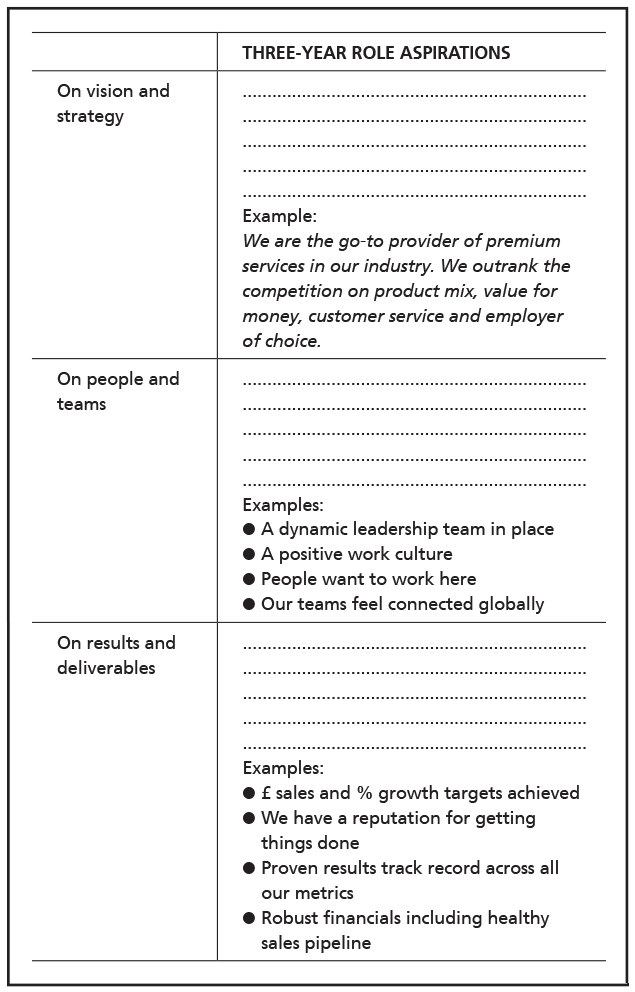
ESTABLISH YOUR FIRST 12-MONTH STRATEGIC PRIORITIES
Having set out your aspirations to be achieved within three years, now write your set of first 12-month strategic priorities in that context, also taking the time to sense-check your priorities against everything you have already learned regarding:
- your key transition challenges
- profile of the role, organisation and market
- early stakeholder conversations
- your career goals and leadership purpose
When you consider the early stakeholder conversations or the role requirements outlined during the recruitment interviews or promotion process, take into account that this recruitment phase may have included a ‘selling’ of the role to you – and some difficult challenges or priorities may have been mentioned but perhaps not in all their full glorious detail.
It happens more frequently than it should that for external recruits the selling process may even have involved taking out or softening the true reality of the challenges of the role. Also, if you had to give three or more months’ notice before starting, it is inevitable that priorities will have shifted and new external factors are in the mix by now. So, what you may need to do before you can write your first 100 days plan is to sit down with your boss to reconfirm and agree in detail the 12-month business priorities.
Clearly, this is also the opportunity to solicit information from your boss on what is expected from you in the first 100 days. Take this as input for your first 100 days plan, because, of course, ideally you would want to do more than what is expected.
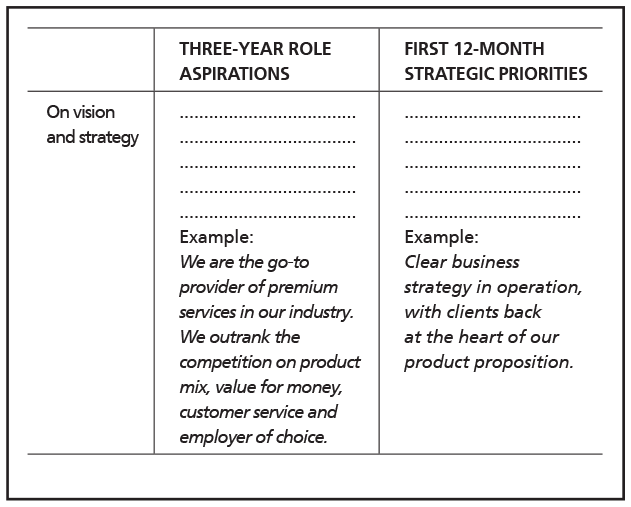
3 Apply the First100assist™ framework
Now you are ready to write your first 100 days plan. With your three-year aspirations and first 12-months strategic priorities as the context, your plan should start with what outcomes you want to achieve by the end of the first 100 days. Your plan should then be structured using monthly milestones (@ 30 days, @ 60 days, @ 90 days) to facilitate monthly reviews of these desired outcomes, and as a way to keep your plan on track.
A set of key themes or a to-do list is not a first 100 days plan
In my experience, executives usually don’t write proper first 100 day plans. Instead they write lists. They have either a set of themes or a list of things to do in their first 100 days, and they confuse this with having a plan. Also, surprisingly, executives tend to narrow their role rather than see it in its full expansive glory. For example, executives tend to view their role as their individual functional area rather than remember that they are also a team member at peer level and must deliver value as a leader of the firm.
Faced with the enormity of a new role, and the new context, many executives oversimplify their plan by focusing on one key deliverable, such as the new marketing director focusing on delivering the marketing plan. And then, subsequently, they focus on the next task – building the team. This linear single-tasking approach is tunnel vision and makes for a very slow start.
Since 2004, we have developed hundreds of first 100 day plans. We have continuously improved our approach in response to our clients’ needs. As such, we have amassed considerable experience and expertise on what constitutes a best practice first 100 days plan. With that as context, I designed the First100assist™ framework. We take any leadership role and reframe it by splitting it across a whole-system view (see Figure 1.1) and devising ten constituent roles.
In the first 100 days of your leadership role, we believe you have to be the following:
- On person: transition maker and unique contributor
- On role: content learner, business achiever, team builder and communications provider
- On organisation: relationship builder, value adder and culture navigator
- On market: market player
These ten constituent roles are shown in the First100assist™ framework in Figure 2.1.
During the profiling exercise, you already started to think about these roles.
ON PERSON
Transition maker = What is the key leadership skills step-up I need to make?
Think about the leadership transition you are making and identify what is new about this challenge. Pay attention to any lack of experience or skills gap. For example, are you moving from a functional role to a general manager role for the first time. Or are you moving from managing a direct report team to more of an influence role. By thinking more deeply about the leadership step-up challenge, you could plan to anticipate or mitigate any issues.
Unique contributor = What are my unique attributes or strengths which I can rely on to contribute to an early advantage or early win?
Reflect on your key talents and what you are naturally good at – and think about how to exploit them to great effect in your first 100 days. For example, if you are a very inspiring communicator, then lean on this to make a strong impression on your role stakeholders and team.
ON ROLE
Content learner = What specific new content do I need to learn?
Think about the switch you are making in terms of industry, company, geography or role function. What research should you conduct in your first 100 days to become more expert or to catch up. For example, do you need to get up to speed on latest trends and relevant digital innovations in this space?
Business achiever = What are the key business targets I need to achieve?
Ask your boss about the targets associated with this role. It is not uncommon that you may be expected to set your own targets, so think through what metrics can be used to define success in your new role. Don’t just consider the obvious ones such as sales targets. Devise recruitment targets, customer service targets or any other relevant ones that would help you demonstrate success by the end of your first 100 days.
Team builder = What must I do to build a high-performing team?
You will need to consider how best to structure the team, how to assess whether you have the right people in the right roles, how to develop a shared mission for your team, how to motivate people and how to assign roles and responsibilities. In 2013 I devoted a whole book to this – titled Lead your Team in your First 100 Days – which is worth reading if you wish to drill more deeply into this key topic, beyond what is covered in this book.
Communications provider = What communications will I need to provide to connect with my stakeholders?
It is not enough to do a good job. You need to keep your stakeholders updated and share your successes along the way. Think about social media as well as traditional platforms for communicating with stakeholders. Think about how often and when to communicate with stakeholders during the first 100 days. In the early days, for some stakeholders you may want to start off with weekly updates and then move to fortnightly and eventually monthly.
ON ORGANISATION
Value adder = How will I contribute effectively to strategy development and add value as a leader of the firm?
Think about whether it is appropriate to continue to deliver against the existing strategy, or whether your appointment is an opportunity to refresh or transform the strategy. You could also think about how to add value to the organisation as a leader of the firm – and not just as a leader of your functional area. For example, you may want to initiate or get involved with a group-wide diversity and inclusion initiative or other passion project.
Relationship builder = How do I build relationships with my key role stakeholders?
It will be important to identify and meet your top ten stakeholders in the first 100 days. How do you intend to make early strong connections, and create a positive foundation for later on in the role? Everyone has been waiting for you to arrive and will be naturally curious to meet you, especially if your leadership will impact on their success as well. But who is it critical to meet in your first 100 days.
Culture navigator = How do I successfully understand and navigate this culture?
Pay attention to what you see, what you hear and what you feel. Be alert to the below-the-surface politics. You may be the smartest person in the room but if you are tone-deaf to culture or politics then you will be like a fish out of water in the first 100 days and beyond. This may impact your credibility and people’s confidence in your ability to make a difference.
ON MARKET
Market player = What can I achieve in terms of a market impact or quick win?
Be alert to spotting opportunities to make a quick win in the first 100 days. What could you start or stop that might make an early impact in your marketplace? Because you are new and bring fresh eyes to the situation, you might be able to bring an idea from your previous company or might be able to spot an obvious gap in processes or in client delivery. Take advantage of your newness to seize an advantage for your team and organisation.
STEP 1: START WITH THE END IN MIND
What do you want to have achieved by the end of your first 100 days?
For each of the ten constituent roles, across your whole system, decide what you want to have achieved by the end of the first 100 days. Then fill in the First100assist™ template with your ten desired outcomes.
First100assist™ Plan Template, using example of Ashley at Zintech bank.
The person (you, as leader)
1 Transition maker – What is my leadership skills step-up?
Desired outcome: by the end of the first 100 days my desired outcome on transition maker is to have achieved the following:
Example:
Made an effective leadership skills transition from managing 500 people in Europe to leading a team of 3,000 across Europe and Asia.
2 Unique contributor – What unique attributes or strengths can I capitalise on for the benefit of everybody?
Desired outcome: by the end of the first 100 days, my desired outcome on unique contributor is to have achieved the following:
Example:
Capitalised on my communications strength to reach out and inspire my entire group of 3,000 people. Re-energised the Premium Services division and helped people to feel more engaged and connected to the company vision and the role we play in successfully achieving it.
The role
3 Content learner – What is my learning curve or content knowledge gap?
Desired outcome: by the end of the first 100 days, my desired outcome on content learner is to have achieved the following:
Example:
Gained an expert understanding of our customer needs, what our existing premium services product set delivers and opportunities diagnosed for strategic innovation.
4 Business achiever – What are my key role deliverables?
Desired outcome: by the end of the first 100 days, my desired outcome on business achiever is to have achieved the following:
(Note: I would expect a bulleted list under the desired outcome for ‘business achiever’ because these are probably the most overtly stated business targets for your role.)
Example:
- Hit our financial year quarterly targets.
- Delivered high impact £££ quick win on premium services strategy.
- Improved premium services processes and team.
- Fresh insights into key customers in Asia and completed new customer segmentation analysis.
5 Team builder – What can I do to build a high-performing team?
Desired outcome: by the end of the first 100 days, my desired outcome on team builder is to have achieved the following:
Example:
Restructured the team, replaced the marketing director, recruited fresh talent, reassigned roles and responsibilities aligned with our three-year vision.
6 Communications provider – How will I communicate my intentions to my team, boss and key stakeholders and how will I provide updates on progress?
Desired outcome: by the end of the first 100 days, my desired outcome on communications provider is to have achieved the following:
Example:
Using a combination of company intranet site, twitter, blog, video, one-to-ones, team meetings and town halls, I will have secured buy-in for my three-year vision, my 12-month priorities, my first 100 days plan and our progress against those priorities.
The organisation
7 Value adder – How will I contribute effectively to strategy development and add value as a leader of the firm?
Desired outcome: by the end of the first 100 days, my desired outcome on value adder is to have achieved the following:
Example:
Refreshed our go-to-market strategy and contributed effectively to the diversity and inclusion firm-wide initiative
8 Relationship builder – Who really matters and how will I build relationships with my key stakeholders?
Desired outcome: by the end of the first 100 days, my desired outcome on relationship builder is to have achieved the following:
Example:
Met my top ten Europe and Asia stakeholders and forged strong early trusted advisor relationships.
9 Culture navigator – What do I need to do to successfully navigate this culture?
Desired outcome: by the end of the first 100 days, my desired outcome on culture navigator is to have achieved the following:
Example:
Improved my understanding of this new environment, how power and politics operate here and how decisions are made here.
The market
10 Market player – What can I achieve in terms of a market impact or early win?
Desired outcome: by the end of the first 100 days, my desired outcome on market player is to have achieved the following:
Example:
Announced a new market insight and a fast proposition into the premium services market place.
Take your ten desired outcomes and write them as a bullet point list on one page. You could borrow from project management objective setting to make your desired outcomes as SMART as possible: S = Specific, M = Measurable, A = Achievable, R = Relevant and T = Time-bound.
This list of ten desired outcomes should now represent your ten most important high-level priorities in the first 100 days. Stop and check. Is there anything you have inadvertently missed in your top ten list? Go back over your transition challenges, the profiling exercise, your career goals and leadership purpose and what you wanted to achieve within a three-year role horizon and within 12 months. Is every key point adequately reflected at a high level under one of these top ten desired outcomes?
Here is the plan for Ashley at Zintech Bank.
STEP 2: BREAK DOWN DESIRED OUTCOMES INTO MILESTONES FOR @ 30, @ 60 AND @ 90 DAYS
Having set out your list of ten most important desired outcomes, the next step is to break down each desired outcome into monthly milestones of 30 days, 60 days and 90 days preceded by initial first-step actions. You can see how this works in the following example.
Write your desired outcome at the top and break it down into manageable timeline tasks underneath: first steps, and then the outcomes you want to achieve by the end of 30 days, by the end of 60 days and finally by the end of 90 days.
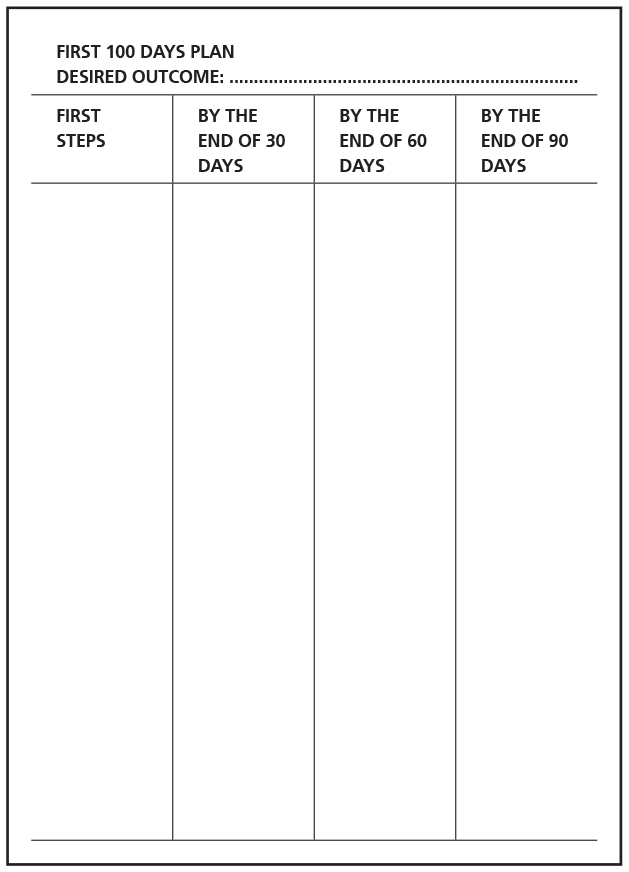
So, for each desired outcome, list the first steps to be taken and list the interim outcomes to be achieved by each 30 day milestone. You will end up with ten slides in total, one for each of the ten desired outcomes.
FIRST-STEP ACTIONS
This is the list of first-step activities or actions you need to take. Taking each desired outcome one at a time, what do you need to do as one or more immediate first steps?
Monthly milestone outcomes
This is not a list of all the day-to-day activities or actions you need to take. These are the monthly outcomes you want to have achieved by each milestone to know you are on track to achieving your desired outcome by the end of 100 days.
By the end of 30 days
- What would you need to have achieved by the end of 30 days to know you are on track to achieving your desired outcome by the end of 100 days? (Fill in the ‘By the end of 30 days’ box.)
By the end of 60 days
- What would you need to have achieved by the end of 60 days to know you are on track to achieving your desired outcome by the end of 100 days? (Fill in the ‘By the end of 60 days’ box.)
By the end of 90 days
- What would you need to have achieved by the end of 90 days to know you are on track to achieving your desired outcome by the end of 100 days? (Fill in the ‘By the end of 90 days’ box.)
Here is Ashley’s plan for one of his desired outcomes.
First 100 days plan
Value-adder desired outcome: Refreshed the three-year vision for Premium Services division and set out clear direction on next 12-month priorities.

Step 3: Sense-check and complete your First 100 days plan
By now, you should have 11 pages of your first 100 days plan. Page 1 is your list of ten desired outcomes to be achieved by the end of your first 100 days. Pages 2 to 11 are for every desired outcome. You should have a dedicated page showing the first steps and the 30, 60 and 90 day breakdown as shown in Figure 2.2 below.
More on this later, but the intention is that you will review your first 100 days plan at the key milestones of 30 days, 60 days and 90 days to ensure that each of your ten desired outcomes is on track throughout the 100 days. This is all about ten key parallel activities and progressing all of them simultaneously – that is how you make the maximum impact in your role.
4 Executive Q&A: advice on writing the best first 100 days plan
Executive Q&A

